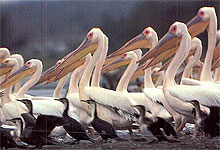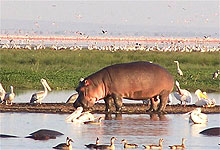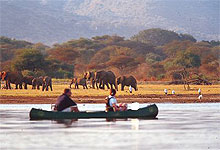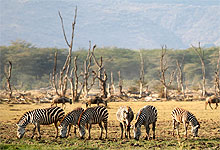Lake
Manyara National Park
Tanzania
Lake
Manyara National Park covers an area of 330 square kilometers
or 127 square miles), of which up to 200 square kilometers
(77 square miles) is lake when water levels are high.
In northern Tanzania. Lake Manyara National Park entrance
gate lies 1.5 hours (126 kilometers /80 miles) west
of Arusha along a newly surfaced road, close to the
ethnically diverse market town of Mto wa Mbu. By road,
charter or scheduled flight from Arusha, en route to
Serengeti and Ngorongoro Crater.)

Lake Manyara National
Park, Tanzania
|

Lake
Manyara Tree Climbing Lion, Tanzania
|

Lake
Manyara National Park Hippo, Tanzania |
Lake Manyara
National Park - Tanzania
Lake Manyara
National Park View
Rates, Discounted Prices - Book & Save Now!
Lake
Manyara National Park
lies in the shadow of the Great Rift Valley whose reddish
brown escarpment wall looms 1,950 feet high (600 metres)
on the eastern horizon. Waterfalls spill over the cliff
and hot springs bubble to the surface in the south.
Much of the park often appears to be in a heat haze
created by the soda lake - Lake Manyara.
Lake
Manyara National Park
attracts considerable bird life, and its surrounding
terrain contains such a rich mosaic of different habitats
that it supports a large number of animals. The park
is accessed by road via the village of Mto wa Mbu, an
eclectic market town where several tribes have converged
to form a linguistic mix like nowhere else in Africa.
Lake
Manyara National Park Animals and Birds
Such diverse surroundings
attract equally diverse species such as monkeys, antelopes,
zebras, hippos and crocodiles, buffalo, giraffe and
a high density of elephants. Lake
Manyara National Park is particularly
known for its tree-climbing lions, who may be seen sleeping
off the heat of the day on a branch instead of a shady
spot on the ground like most other lions.
Fish-eating birds inhabiting
the lake include pelicans, storks, cormorants and Egyptian
geese. Flamingoes co lour the lake pink as they arrive
to feed at the lake during their migration. One unforgettable
sight is a giant flock of red billed queleas who gather
in their thousands and waft over the water like a giant
swarm of insects.
Lake
Manyara National Park Seasons
Rainy
Season: Short rains are November and December
when it gets hot and humid, and the long rains are from
March to June. These are the best times for bird watching,
waterfalls and canoeing.
Dry Season: typically it is dry in
the cooler winter months of July to October, which is
the best time to view game.

Canoe
Trip on Lake Manyara
Tanzania
|

Lake
Manyara National Park Wildlife
|

Lake
Manyara National Park Hippo Yawn |
Lake
Manyara National Park
Highlights
•
Lake Manyara Serena Active Forest
Hike
•
Canoe Trip on Lake Manyara
•
Diverse scenery and animals
• An abundance of elephants
• Water birds in abundance
•
Tree-climbing lions
•
Night game drives
Lake
Manyara National Park
Facts
•
It attained National Park status in 1960
•
The park is 127 miles² (330 km²) of which
89 miles² (230 km²) is Lake Manyara
• The park is 78 miles (125 km) west of Arusha
town, from where it is a half an hour flight or a two-hour
drive
Lake
Manyara National Park Accommodation |
|
Lake
Manyara National Park Safaris
& Tours |
|
Booking
& Reservations for
Lake Manyara National Park about 1.5 hours (126 kilometers
/80 miles) west of Arusha along a newly surfaced road-
Tanzania
Booking
Office Tel: + 254 (0)
20 2437871
Mobile : + 254 - 721242711
Email:
[email protected]
